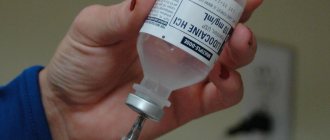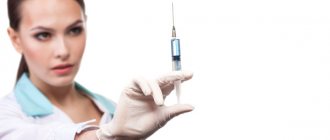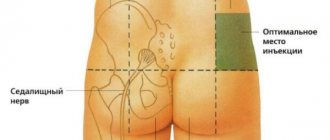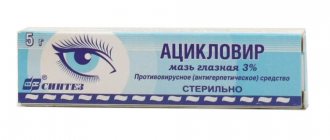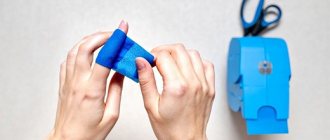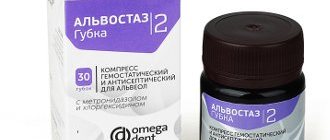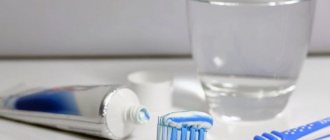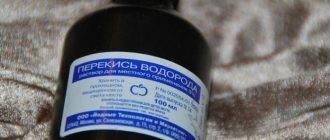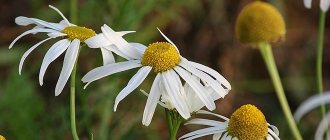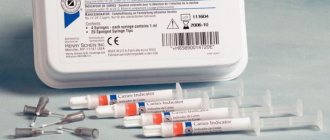Video
Found an error in the text? Select it, press Ctrl + Enter and we will fix everything!
Article updated: 08/20/2018
Ointment for any bruises is no less important for children than pacifiers, diapers and first foods. Before they even take the first step, children are actively learning and mastering the world around them. Injuries are inevitable due to increased activity and lack of experience. But since we cannot protect babies from harm, we need to prepare to protect them from possible consequences. Correctly selected medications will significantly help with this.
Basic rules for choosing ointments for bruises
Ointments for children against bruises and sprains help only if you choose and use them wisely. There are several groups of funds.
Painkillers are anti-inflammatory non-steroidal drugs for topical use. They relieve pain and help in case of dislocation, sprain, or rupture of muscles and ligaments.
Cooling medications are relevant for severe bruises of soft tissues and muscles, when the following are intact:
- ligaments,
- cartilage,
- tendons,
- bones.
When applied to the skin, they give a feeling of coolness, reduce pain and swelling. Warming analogues irritate the skin, activating blood flow to the damaged area. This is only useful a few days after the injury occurs. At first, they cannot be used.
It is advisable that your home medicine cabinet contains products from each group. It is important to remember that in the first day after injury, only drugs for inflammation and pain (including cooling) are allowed.
Warming agents are prohibited at the initial stage. If the skin is broken, that is, the injury is accompanied by wounds and abrasions, the application of such products is, in principle, harmful.
If a dislocation or fracture occurs, professional assistance from doctors at the emergency room is required. Having provided such assistance, the doctor will prescribe a suitable ointment for pain. The product will help you endure discomfort in the first few days after the injury.
Chondoprotectors - ointments for joint pain and inflammation
Under the influence of such agents, articular cartilage is restored and protected from damage. This joint cream partially relieves inflammation, but is not absorbed into the blood. The continuous functioning of cartilage also occurs due to the fact that the active elements affect the metabolism in it.
There are three generations of topical treatments:
- First. These are gels and ointments of biological origin. Contains an extract from animal and fish cartilage.
- Second. Contains chondroitin and hyualurnonic acid.
- Third. Combined ointments for joint pain. Contains second generation elements in different combinations. Some types additionally contain anti-inflammatory ingredients, polyunsaturated fatty acids.
According to scientists, the greatest effect is achieved when using third-generation gel and ointment. This anti-inflammatory cream is better absorbed and is quickly incorporated into the metabolism of cartilage tissue. Products containing hyaluronic acid are effective.
At the same time, external agents have a lower therapeutic effect. Often prescribed in conjunction with other treatment methods and when performing phonophoresis.
Basic rules for choosing ointments for bruises
It is possible to obtain the proper therapeutic effect from treatment with ointments used for bruises only when they are correctly selected. There are many such drugs on sale. All of them are divided into groups according to their main purpose:
- pain relievers - non-steroidal anti-inflammatory drugs that relieve pain caused by dislocations, sprains, ruptures of muscles and ligaments,
- cooling - have a positive effect on tissues and muscles injured by severe bruises without severe damage. They cool the bruised area with soothing coolness, reduce pain and swelling,
- warming ones, on the contrary, act irritatingly, providing a rush of blood to the area affected by the bruise, which is especially important three days after the injury.
At home, it is advisable to have appropriate lubricants belonging to each of these groups. When a bruise occurs, painkillers and cooling medications are usually used. Warming compounds do not bring any benefit in such cases. They are intended for later use (3 days after the injury).
Tools Overview
The most effective medications with a cooling effect are:
"BystrumGel"
The drug is indicated for use in diseases of the veins, arthralgia, pain in muscles and tendons. Effective for osteochondrosis, osteoporosis, radiculitis, arthrosis, spondylosis and other diseases of the musculoskeletal system. It has an analgesic, antithrombotic, regenerating effect, promotes the resorption of hematomas and the elimination of hyperemia.
"Gevkamen"
It has a pronounced analgesic and local anesthetic effect due to irritation of sensitive nerve endings located on the surface of the skin. Contains 3 active substances that provide a high effect: levomenthol, camphor and eucalyptus oil. Used for arthralgia, myalgia, neuralgia.
"Efkamon"
The drug "Efkamon" contains the active component methyl salicylate, found in most cooling ointments. The product also contains menthol, a complex of natural oils, camphor and excipients.
It has an analgesic and irritating effect, improves local blood circulation, due to which muscle spasms, swelling, and redness disappear. "Efkamon" is effective for bruises, sprains, neuralgia, lumbago and other diseases accompanied by painful sensations.
"Menthol ointment"
One of the most famous and effective cooling agents. It not only has an analgesic effect, but also relieves itching and irritation, soothes the skin, and has a weak antiseptic effect. Used for pain in joints, muscles, neuralgia, muscle injuries.
"DIP Relief"
A Scottish-made menthol ointment that has a pronounced effect. The composition contains menthol, which has a cooling and analgesic effect, and ibuprofen, which helps relieve the inflammatory process in muscles and joints. The drug is used for neuralgia, myositis, arthralgia, some types of arthritis, lumbago, muscle and joint injuries.
"Boromenthol"
Boromenthol contains menthol, boric acid and petroleum jelly, which provides a viscous consistency to the product. The medication has anti-inflammatory, analgesic, antiseptic, and wound-healing effects. It is used for pain in the muscles, as well as for various damage to the skin.
"Fineis"
The ointment has a complex effect and has a cooling and warming effect. The composition contains menthol, eucalyptus oil, ethyl alcohol. All components provide a pronounced analgesic, anti-inflammatory, antiseptic effect. Finice helps relieve muscle tension and eliminate swelling. Used for myalgia, myositis, arthralgia, arthritis, bruises, sprains. Effective after insect bites.
"Bom - Benguet"
Contains methyl salicylate and menthol, which have a pronounced analgesic, local anesthetic effect, help eliminate inflammation, swelling and redness. Indicated for use in sciatica, lumbago, arthralgia, myalgia, radiculitis, diseases of the musculoskeletal system accompanied by pain.
"Ben is Gay"
Ben-Gay cream contains methyl salicylate, menthol and auxiliary components. Has an analgesic, anti-inflammatory, local irritating effect. The cream improves blood circulation at the site of application and helps relieve muscle tension.
How to choose the right product?
Pharmacies offer a varied selection of ointments, balms, gels, and creams for bruises belonging to these groups. Which ones should you buy? In order not to make a mistake in choosing, it is important to adhere to the following requirements:
- ointment for bruises should be suitable for the child’s age - products for very young children, primary schoolchildren and teenage children differ in the strength of the chemical compounds used,
- When choosing an ointment, you need to pay attention to the possibility of individual intolerance and the occurrence of an allergic reaction - at the slightest suspicion, you need to cover a small area of skin with the drug and leave it for some time. If the allergy does not manifest itself, then further use of the product will be quite acceptable,
- is attentive to the composition of ointments - you need to buy only those that can really help. A consultation with a doctor or pharmacist will help determine the right remedy.
You should know that ointment for bruises and injuries, no matter how good it is, only alleviates the condition and does not cure the problem. True, skillfully selected, it significantly shortens the healing and recovery period.
The rules for using such ointments and creams are usually indicated in the instructions for the drug, which must be followed. They promote the restoration of soft tissues, prevent the fragility of blood vessels, and promote the resorption of hematomas. However, if the skin is damaged, then such products cannot be used.
How to Apply Cooling Cream
Applying local anesthetic cream for hair removal is not at all difficult, but there are still a few things to pay attention to.
Sensitivity testing
Before treating the skin with an anesthetic cream before depilation, it is imperative to conduct a sensitivity test. To do this, apply a small amount of the product to the elbow area and analyze the result after 30-40 minutes.
In the absence of any irritation, rashes or redness, this product can be used in the future without fear.
Pain relief before the procedure
After the sensitivity test has been carried out, you can apply the product to the body in the required volume.
Important ! The application of anesthetic agents is prohibited in case of any violation of the integrity of the skin.
- It is recommended to steam the skin first, so the hairs will be easier and less painful to remove.
- The area to be treated must be thoroughly dried, and then an anesthetic drug must be applied. To achieve maximum effect, the skin is additionally covered with cling film and left for the amount of time specified in the instructions.
- The remaining cream is removed with a napkin or paper towel.
- You can begin removing excess hair.
List of drugs
Lubricants that help overcome the consequences of bruises are used immediately after the injury occurs. As for children, their use is carried out in accordance with age characteristics.
For infants, the medications prescribed by pediatricians usually have a more gentle composition, these are:
To alleviate the consequences of minor injuries, children from 1 year to 5 years of age are also offered a considerable selection of lubricants:
Children from 5 years of age are mainly prescribed lubricating preparations consisting of several components, which provide higher effectiveness:
First aid
If it so happens that yours gets hit hard, don’t panic, assess the situation sensibly and only then take action:
- when the pain occurs instantly, you can think about a sprain (if the muscles are damaged, it does not immediately make itself felt). With stretched ligaments and muscles, the bruise site will become bluish in color. It is important to calm the person who is injured, numb the clogged area with ointment, and then take him to the emergency room,
- if a hematoma occurs, you should immediately put cold on the clogged area, then (for a minor bruise) lubricate it with medicinal ointment,
- Never use an iodine mesh for babies - this can lead to an overdose of iodine in their body. This method of treatment can only be used from adolescence,
- A pressure bandage using an elastic bandage will greatly alleviate the child’s condition after a bruise.
Useful tips
Every parent should clearly know what to do if their baby gets hurt. The following recommendations are suitable for this:
- When such a pathology occurs, infants are allowed to fearlessly lubricate the clogged area with arnica or calendula oil. They perfectly eliminate swelling, are safe and inexpensive.
- You should never use folk remedies when trying to help your baby in this case. After all, most of them do not remove the intractable pain that is present in such pathology. Modern medicine is more suitable here. And for those who do not accept synthetic drugs, you can always choose a plant-based product.
- If your baby is injured in any way, it is best to always seek medical help. Proper prescribing of therapeutic techniques will help to effectively speed up his recovery.
- How to choose the right product?
- List of drugs
- Children under 1 year
- Children from 1 year
- Children from 5 years old
- For teenagers
- For bruises
As soon as babies master independent movement in space, long before their first steps, they begin to actively explore the world. This process continues and gains momentum after children learn to walk. At the same time, falls, contusions, bruises and abrasions are inevitable.
It is impossible to protect the baby from them. But you can always have on hand remedies that will relieve pain from such injuries. In this article we will provide an overview of the most effective drugs for bruises and sprains approved for use in childhood.
How to choose the right product?
The benefits of drugs that relieve pain and swelling from bruises and sprains, eliminate bruises, are obvious to the whole family. But if adults go to the pharmacy without any extra thought and buy themselves any post-traumatic medicine, then this approach is unacceptable for children. Most adult ointments for bruises and gels for hematomas can cause allergies in a child, and this can lead to even greater swelling.
Before choosing a remedy specifically for an inquisitive child, you should understand that all drugs that are used after injuries are divided into three groups according to the type of action:
- Painkillers. This group includes ointments and gels, as well as sprays with a pronounced analgesic effect. We are mainly talking about non-steroidal anti-inflammatory drugs for topical use. You cannot do without such a medicine in case of severe sprains, dislocations, ruptures of ligaments and muscles.
- Coolants. Such drugs are indispensable for severe bruises of muscles and soft tissues. With such injuries, the bones, tendons, cartilage and ligaments remain intact. Ointments and gels of this group, when applied to the skin, create a cooling effect, and also reduce swelling and moderate pain.
- Warming agents. These drugs cause irritation on the skin, which activates blood flow to the injured area of the body. This effect is useful for bruises and sprains a few days after the injury. In the early stages, warming drugs cannot be used.
- If no more than a day has passed since the injury, you can only apply painkillers and anti-inflammatory drugs, including cooling gels. Warming ointment is prohibited!
- If more than three days have passed since the injury, you can start using warming ointments.
- If the integrity of the skin is compromised, if the injury is combined with abrasions or wounds, the product should not be applied at all.
- Ointments do not help with fractures and dislocations. You need qualified medical care in an emergency room. But after providing assistance, the doctor may allow the use of pain-relieving ointments in case of a sprain; they will help to somewhat reduce pain during the first days after the injury.
Treatment of gum diseases
Inflammations on the gums and in the mouth do not allow even adults to live in peace, not to mention small children who develop them when teething.
Inflammatory gum diseases:
- Stomatitis.
- Gingivitis.
- Periodontal disease.
- Oral candidiasis.
Often the doctor prescribes rinsing with special solutions and anti-inflammatory ointment.
The most famous of them:
- Traumeel C - it is used for pain in the baby’s gums that is associated with teething. Contains natural herbal ingredients: mountain arnica, chamomile, St. John's wort, yarrow, perennial daisy, comfrey, belladonna. Quickly relieves swelling and inflammation.
- Heparin - has a fatty consistency and includes heparin and benzocaine, they easily relieve swelling and inflammation, and help resolve blood clots.
- Decamine 5% - contains dequalinium chloride. It has an antibacterial and antifungal effect on inflamed areas.
The effectiveness of the medicine depends on the cause of the inflammation. For example, for oral candidiasis, Traumeel S will be ineffective.
List of drugs
Manufacturers indicate that the gel should not be taken until the age of 15, however, this is not a ban, but only a recommendation to use the drug carefully, because its effect on children has not been sufficiently studied.
To treat an abrasion with balm, you should first treat it with a non-alcohol antiseptic; for bruises and hematomas, the ointment is applied in a medium layer to clean and dry skin. The balm can be applied 2 to 5 times a day.
In practice, the ointment is recommended for children after 1 year, but its use must be agreed with the attending physician.
The drug should not be used for abrasions or any skin disorders. There are no contraindications for use in childhood, but doctors recommend using the gel for children after one year of age to avoid an allergic reaction.
The gel is rarely prescribed for monotherapy; it is usually recommended as part of complex treatment, for example, the consequences of injury. Many traumatologists do not recognize this remedy at all, since it is not medicinal.
The product is considered quite allergenic, and therefore it is recommended to conduct an allergy test after purchase - apply a little gel to the child’s hand, on the back of the hand and wait about an hour. If redness or hyperemia of the skin appears, the product should not be used.
Among the most effective:
If a child plays sports, then a tube of such a drug in the home medicine cabinet is simply necessary, because the product allows you to very quickly achieve the desired effect - numb the ligaments that the child has sprained, relieve swelling in case of a severe bruise.
You can apply the gel or cream to the injured area no more than three times a day. In this case, treatment should not be delayed for more than 14 days.
Names of anesthetic gels and ointments containing lidocaine
Have you been trying to heal your JOINTS for many years?
Head of the Institute for the Treatment of Joints: “You will be amazed at how easy it is to cure your joints by taking the product for 147 rubles every day.
The pharmaceutical industry produces a large number of analgesics in the form of ointments. The advantage of drugs of this form over tablets is that they are more convenient to use and have a smaller list of contraindications and adverse reactions.
Our readers successfully use Sustalaif to treat joints. Seeing how popular this product is, we decided to bring it to your attention. Read more here...
Available in the form of a dental gel and solution for external use. Contains lidocaine, chamomile flower extract, lauromacrogol.
Used in pediatric practice. The gel ensures an uncomplicated and painless appearance of the first incisors, baby and molars. Dentinox also helps relieve gum inflammation.
Produced in the form of a gel for topical use. The mechanism of action is based on blocking voltage-dependent Na+ channels, which prevents the conduction of impulses along nerve fibers. Has vasodilating properties. Dinexan A is used in dentistry for terminal anesthesia of mucous membranes before operations and suturing.
Produced in the form of a gel. Contains chlorhexidine and lidocaine. This is a combined agent with local anesthetic and antiseptic effects. It is used to treat inflammation in the oral cavity, during catheterization of the urethra, surgery, and endoscopic studies.
This is a brown-yellow gel with a specific odor. Contains lidocaine hydrochloride and cetylpyridine chloride, xylitol and castor oil. Kalgel is a combination product. Lidocaine anesthetizes, cetylpyridine chloride inhibits the reproduction and growth of fungi and bacteria. It is used to eliminate pain and inflammation in children during teething.
Kamistad is a local anesthetic gel. Contains chamomile flower tincture and lidocaine. It has anesthetic, astringent and antiseptic properties. Dentists often use Kamistad to treat stomatitis, gingivitis, pain due to the eruption of wisdom teeth, and to alleviate the condition after maxillofacial orthopedic surgeries.
Produced in the form of a gel for topical use. The main active ingredient is lidocaine. It is used in dentistry, otorhinolaryngology, gynecology, and obstetrics. Suitable for terminal anesthesia of oral mucous membranes.
Doctors often use Xikain to remove tartar, sutures, perform endoscopic and instrumental studies (rectoscopy, insertion of a probe), operations on the cervix, vagina, and to treat burns.
Available in gel form. The active ingredients are lidocaine and chlorhexidine. It has an analgesic and antiseptic local effect. It is used to eliminate the inflammatory process in the oral cavity, for the purpose of anesthesia during catheterization of the urethra and endoscopy. Can be used to prevent the development of infection.
Contains etonium, lidocaine and gentamicin. Ligenten has a combined local effect. Gentamicin destroys gram-negative and gram-positive microorganisms. The effect of this substance does not apply to anaerobic bacteria. Etonium enhances the effectiveness of gentamicin. Lidocaine has analgesic properties. Ligenten is used in urology and gynecology.
This is a local anesthetic drug. Luan relieves pain and has a softening effect. Tactile sensitivity is not impaired. Prevents the development of spasm when performing diagnostics. The gel can have different concentrations. Luan 2.5% is used in preparation for endourethral procedures, 1% for endoscopic examination.
This is a topical gel based on lidocaine. It is used in otorhinolaryngology (when performing surgery on the nasal septum, electrocoagulation), dentistry (as a local anesthesia, for extirpation of baby teeth, when applying sutures and removing tartar), obstetrics, gynecology (when processing an incision, episiotomy).
Lidochlor is suitable for eliminating the pharyngeal reflex and nausea during radiographic examination. The effect develops five minutes after application.
Also used to relieve pain from burns, dermatitis, and insect bites.
Available in the form of ointment 0.4% and 0.2%. Contains nitroglycerin and lidocaine. Dilates blood vessels and normalizes blood circulation. Used in proctology to treat hemorrhoids, eliminate anal fissures, and relieve pain. In urology it is used to increase potency.
It is produced in the form of a homogeneous white ointment with a characteristic odor. Oflocain-Darnitsa contains lidocaine hydrochloride and ofloxacin. Doctors use this remedy to treat infected complicated wounds, for amputation of limbs and to prevent postoperative complications. Also helps in the treatment of burn wounds. It is a good drug for the prevention of skin diseases caused by bacteria sensitive to ofloxacin.
Available in the form of a white cream. Contains prilocaine and lidocaine. Can be used on adults and children. It is used for superficial anesthesia before surgery, vascular catheterization, and puncture.
First aid
If a child falls and screams, cannot get up, or complains of pain in the arm, first of all you need to calmly and sensibly assess the situation:
When spraining ligaments. The symptoms of a sprain differ from muscle injuries primarily in the timing of the onset of pain. If the ligaments are stretched, the pain comes instantly, if the muscles are damaged, the pain will be delayed over time. When ligaments and muscles are sprained, swelling appears; the swelling site sometimes looks somewhat bluish. In this situation, the child should be reassured, the injured limb should be kept at rest, the damaged area should be lubricated with pain-relieving ointment or sprain gel, and the child should be taken to the nearest emergency room.
For bruises. The most common childhood injury is a bruise. If your child has a hematoma on his face, leg, arm or other part of the body, at the first stage it is important to apply something cold. A piece of ice wrapped in a kitchen towel or cloth napkin will do. The main thing is not to cause local frostbite.
- No matter what grandmothers and traditional healers say about the benefits of an iodine mesh for bruises and sprains, it is better to refuse such treatment in childhood. The baby's skin is delicate and very quickly absorbs and immediately absorbs iodine. Very often the result is an overdose of iodine, which poses a serious danger to the child. Therefore, if desired, a teenager can draw a mesh with iodine, but this is contraindicated for a child.
- To alleviate a child’s condition after a bruise or sprain, gels and ointments alone are not enough. It is worth learning how to apply a pressure bandage. To do this, it is best to use an elastic bandage. It is important not to overdo it or cut off the blood supply by bandaging too tightly. The optimal pressure of the bandage is considered to be such that the bandaged limb does not change the color of the skin and does not get cold.
Usually bruises do not need to call a doctor; they can be easily treated at home. However, there are several situations in which the child should still be taken to the emergency room:
- extensive hematoma on the head;
- severe bruise of the forehead or temporal lobe;
- an extensive hematoma on the bridge of the nose, under the eyes of a small child - an infant and a child under one and a half years old.
The consequences of such bruises and hematomas can be unpredictable, especially for children, because head injuries are always fraught with hidden pathologies that cannot be cured with ointments and gels. Therefore, it is important that the child is examined by a traumatologist, and, if necessary, by a neurosurgeon.
A bruised nose, bridge of the nose, lips with swelling are almost always harbingers of the imminent appearance of a hematoma. Appropriate assistance should be provided. More complex and deep bruises need to be examined by a traumatologist. This applies to bruises of the knee and elbow joint, which cause swelling and limited movement of the joint.
If the child’s limb bends unnaturally, if the swelling increases rapidly and any attempts to move cause severe pain, you should not find out on your own what happened to the baby. Any options are possible - from cracks to displaced fractures. This can only be determined by taking an x-ray of the damaged area.
Do not hesitate - the child must be taken to the emergency room or any nearest hospital as soon as possible.
Useful tips
Recommendations for parents are as follows:
- For babies under one year old, you can treat the bruise with arnica oil or calendula oil. Both of these drugs have anti-edematous properties. These oils are inexpensive and can be purchased at any pharmacy.
- You should not treat your child’s severe bruises, sprains and dislocations with folk remedies. Potato compresses and plantain lotions do not eliminate the severe pain that is certainly present with such injuries, at least in the first few days.
- Modern medicine offers more effective means in which the baby does not have to endure pain. If you have concerns about synthetic drugs, you can always choose a herbal-based drug.
- Some forms of injury require not only local treatment, but also the simultaneous administration of anti-inflammatory and analgesic drugs orally. Be sure to ask your doctor what pills you can give your child if the pain gets worse at night.
To learn how to properly provide first aid to a child for bruises and other injuries, watch the following video.
medical reviewer, psychosomatics specialist, mother of 4 children
Popular ready-made creams
There are a significant number of ready-made creams on the market to numb the skin before depilation. It is enough to choose the appropriate option for yourself and the hair removal procedure will no longer bring discomfort.
"Emla"
Today, Emla anesthetic depilatory cream is the most popular anesthetic among the fair sex.
The composition of Emla depilatory cream includes elements that are used for local anesthesia: prilocaine and lidocaine.
Penetrating into the skin, they act as an anesthetic, and the degree of their effect directly depends on the dose of the drug used and the duration of its presence on the skin area.
Instructions for use
How to use Emla cream before hair removal is described in detail in the instructions, which are included in each package of the drug. If you use the cream according to these instructions for use for hair removal, the result will be the most effective and noticeable.
First of all, you need to clean the area of skin. After this, the cream is applied in a thick layer and covered with adhesive tape, which is also included in the package.
Such manipulations are necessary so that the anesthetic penetrates more deeply into the skin, and the active elements of the drug do not evaporate. If depilation will be carried out on large areas of skin, then instead of a special tape, you can use ordinary cling film.
The layer that is under the film can be updated from time to time.
Speaking about Emla cream and its use during hair removal, it is worth noting that it is very convenient to use it to prepare for the hair removal procedure in advance, before going to the salon, for example, since the effect is quite long-lasting. Advice !
When using Emla cream before hair removal, you need to remember that the composition will not begin to act instantly, but only after 25-30 minutes. The most noticeable effect of this anesthetic can be achieved after an hour. The effect will last up to 4-5 hours. According to the instructions for use for depilation, a number of precautions must be observed:
- Do not apply the product to the skin around the eyes.
- If there are scratches, inflammations, open wounds, etc. on the skin, the drug cannot be used.
- Under no circumstances should you allow the cream to get into your ear.
- If any side effects occur, the product should be immediately removed from the skin.
Watch a video about using Emla cream before hair removal.
Analogues of Emla cream
There are also a number of analogues of Emla cream on the market, which can also be quite successfully used for pain relief during hair removal. In comparison, analogues may turn out to be significantly cheaper, and in terms of effectiveness for relieving pain during depilation, they are not much inferior.
"Light Dep"
The active element of this drug is anestoderm.
Its effectiveness is slightly lower compared to prilocaine and lidocaine, but the advantage of this drug is its hypoallergenicity. "Light Dep" is a combination product that mainly affects the epidermis.
It is able to block nerve endings while maintaining adequate sensitivity to temperature changes. This is very important in cases where, for example, hot wax is used. This way you can avoid burns.
This remedy usually does not cause irritation. It also does not penetrate into the blood.
It must be applied using a cotton pad in several layers. The layers themselves should be quite thick. The skin is additionally covered with cling film. If Light Dep is used on the face, no foil is needed.
Leave the cream on the skin for 15 to 60 minutes. Then the remaining product is removed and you can begin hair removal.
"Dr. Numb"
Doctor Namb cream contains benzyl alcohol and lidocaine. It is able to block nerve impulses that come from the skin.
Before using it, the skin should be washed with soap, or additionally treated with alcohol.
You need to apply a fairly thick layer of the product; you can cover it with a film or bandage to enhance the effect. Leave the cream on the skin for about 30 minutes.
The effect is noticeably lasting - from 3 to 5 hours. People who suffer from heart disease, as well as those who are allergic to lidocaine, use “Dr. Numb" is not allowed.
It happens that it can cause skin irritation or a rash, so you must first conduct a skin susceptibility test.
Aspirin should not be used before hair removal. It can thin the blood, resulting in bleeding during the depilation process.
"Deep Numb"
The remedy for preventing pain “Deep Numb” is made on a water basis. It is non-greasy and well eliminates discomfort during depilation.
Before applying it to the skin, the area must be disinfected. The effect lasts about 40-60 minutes
“Deep Numb” temporarily blocks pain signals traveling along the nerves. It is recommended to apply it approximately 40 minutes before the start of the hair removal procedure.
First, the desired area is washed with soap and wiped dry. Then you can apply the cream.
As for the bikini area, the product can be applied to the pubic area and labia. The buttocks and thighs area should not be covered with this cream. During exposure, a slight burning sensation may be felt; this is normal and usually goes away after a few minutes. Laying plastic film on top is allowed.
"Depilflax"
"Depilflax" is a gel that contains menthol, essential vegetable oils and chamomile extract.
Most often it is used before waxing. This drug cools the skin well and also disinfects it.
The cream should be applied with gentle massage movements and left on for just a few minutes.
"Depilflax" will moisturize the hair and make it easier to remove.
This product works very well against ingrown hairs. You should pay attention to the presence of allergies to the components included in the Depilflax cream.
Lidocaine
Lidocaine is a drug that is considered the most effective in the field of pain relief. Works very well for removing unwanted hair in the deep bikini area.
Available in two versions: spray and injection.
The spray will numb the skin well, but will not relieve all unpleasant sensations, because the active substance will not be able to penetrate to the subcutaneous layer where the hair follicles are located.
As for injections, they can completely remove the sensitivity of the desired area.
When choosing the second option for pain relief, it is important to take a responsible approach to choosing a beauty salon where the hair removal procedure will take place. After all, you need to adhere to the level of hygiene as much as possible, and also give the injection correctly.
Due to the fact that lidocaine is a drug, it also has contraindications. First of all, this is intolerance to the active substances contained in the drug. This does not have to be an obvious allergy, so a sensitivity test must be carried out first.
"Super Numb"
“Super Numb” is a drug that is available in the form of a cream.
It is made on a water basis, so it can penetrate the skin relatively easily and quickly. This remedy will relieve unpleasant painful sensations during the hair removal procedure, and the effect will last for 4 hours. The country of origin is the USA.
Before applying the drug, the skin should be washed with soap and water and then wiped dry. The product is applied in a thin layer and covered with cling film to activate the active ingredients.
You need to keep it on the skin for 30-60 minutes, after which you can remove hair. Super Numb should not be used on damaged areas of the skin.
